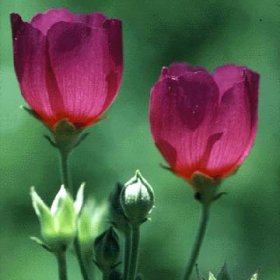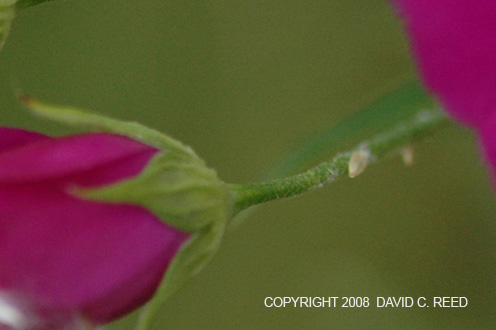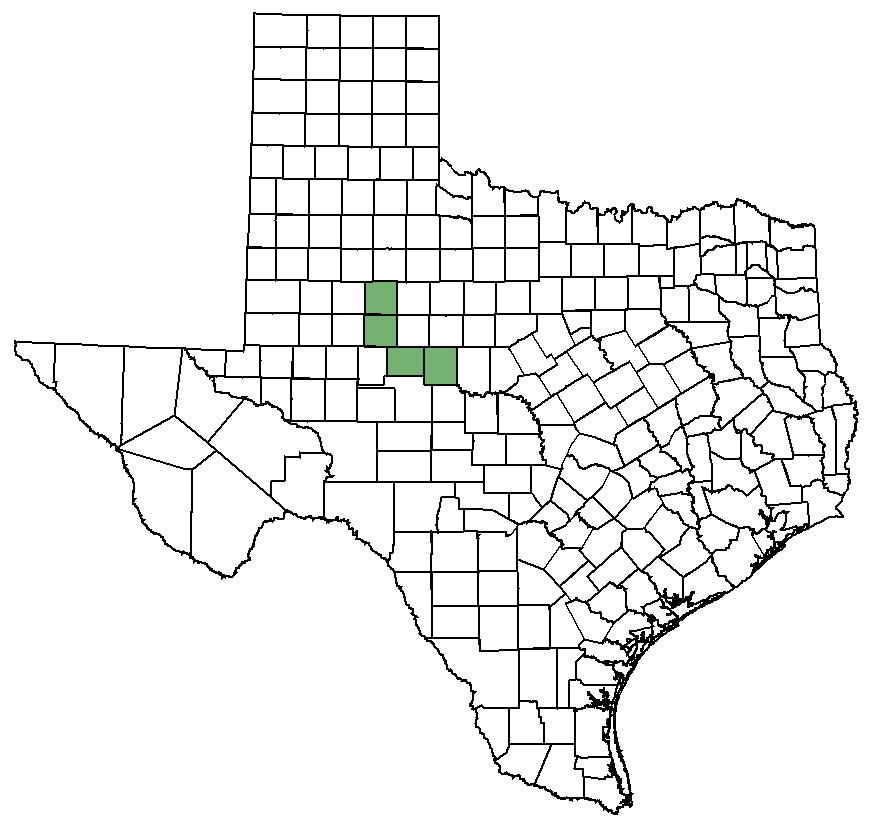Federal and State Listed Species of Texas:
Texas poppy-mallow
Global Location
Texas poppy-mallow only occurs in the Rolling Plains of Texas in Coke, Mitchell, Runnels, and Scurry counties.
null
Credit: null
Description
Texas poppy-mallow is an erect perennial with a stem and taproot that, respectively, grow up or down to 1 m. All green parts of the plant are covered with a dense layer of branched, star-like hairs, except for the fruit, which has a thinner layer of unbranched hairs. The star-like microscopic hairs split into about eight radiating arms. The lower leaves (4-6.5 cm long, 3.8-7 cm wide) form a rosette, are more or less circular in outline and shallowly lobed. Leaves on the stems are of similar shape but slightly smaller (4.2-5 cm long, 5.5-6.2 cm wide), with 3 or 5 deep, blunt lobes, and smooth leaf edges (usually not toothed). The 5-petaled, red-wine colored flower is 3-4 cm tall and 1.4-2 cm across and resembles a wine cup. Below the flower are two green, leaf-like structures. The upper structure cups the flower base and has five pointed lobes. Below this is a whorl of 1-3 very narrow, leaf-like structures, which are 0.7-1.4 mm wide. Texas poppy-mallow fruit is 7.8-11.9 mm in diameter and composed of usually 12-17 sections. When dry, the sections fall apart, releasing the seeds. The black seeds are kidney-shaped.

Texas poppy-mallow has two whorls of leaf-like structures below the flower.
Credit: Paul Montgomery
Texas poppy-mallow is an erect plant with 3 or 5 deeply lobed leaves on the stem.
Credit: Jackie Poole - Texas Parks & Wildlife Dept.
null
Credit:
Similar Species
Woodland poppy-mallow (Callirhoe leiocarpa) has hairs with four arms and lacks the second (lower) whorl of very narrow, leaf-like structures under the flower. Winecup (Callirhoe involucrata) has trailing stems (rather than erect) and is a shorter plant (≤60 cm tall) compared to Texas poppy-mallow. The lower surfaces of the winecup leaves have star-like hairs and mostly unbranched hairs on the upper surfaces of the leaves.

Woodland poppy-mallow has only one whorl of leaf-like structures below the flower.
Credit: David Reed - Texas A&M Vascular Plant Image Gallery
null
Credit:
null
Credit:
null
Credit:
null
Credit:
null
Credit:
Floral Characters
nullLeaf Characters
nullnull
Credit:
null
Credit:
null
Credit:
Habitat
Texas poppy-mallow occurs in grasslands or shrublands along terraces of the upper Colorado River in very deep sandy soils.
Habitat of Texas poppy-mallow.
Credit: Jackie Poole - Texas Parks & Wildlife Dept.
Life Cycle Events
Flowering occurs from May to June. The above-ground portion of the plant dies back in mid-summer and a rosette forms in very late summer with stems bolting in the spring.
Survey Season
Although recognizable anytime the rosette is present, Texas poppy-mallow is most visible while in bloom, May to June. In extreme drought, all above ground parts may be absent or very stunted.
null
Additional Information
- Rare Plants of Texas
- U.S. Fish and Wildlife Service
- NatureServe
- Flora of North America
- Center for Plant Conservation
- Poole, J.M. and G.K. Janssen. 1997. Managing and monitoring rare and endangered plants on highway right-of-ways in Texas. Section 6 final report. Austin: Texas Parks & Wildlife Department.

Comments
In addition to the extremely small geographic area where the plant grows, the seeds stay close to the parent plant, are short-lived, and most do not sprout. These facts along with the overwhelming preference for deep sandy soils severely limit numbers and populations of the Texas poppy-mallow.